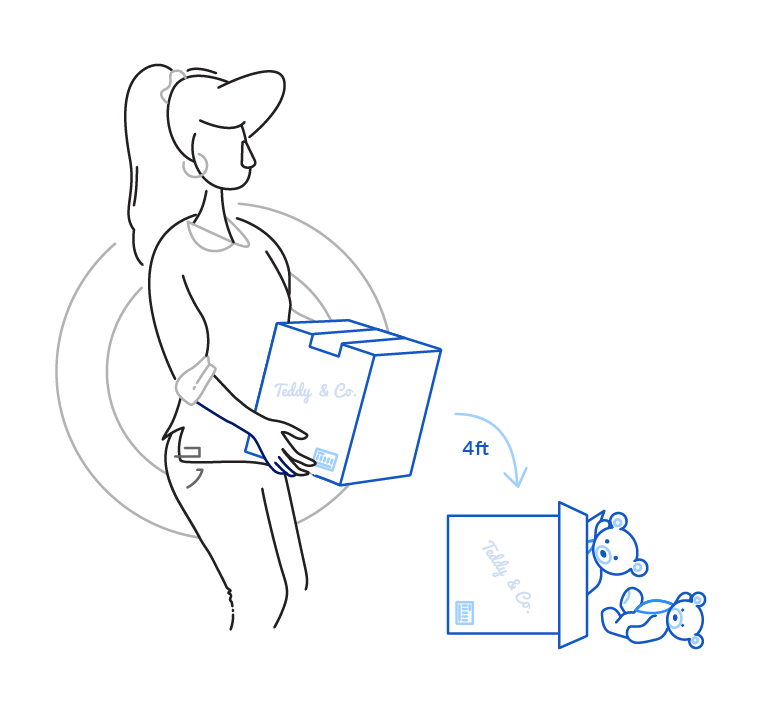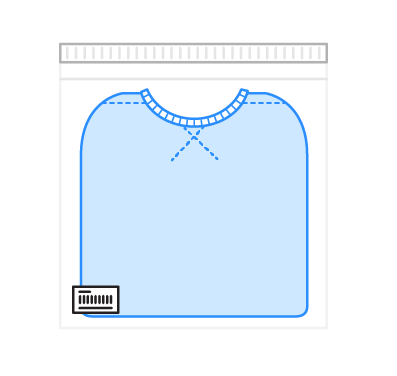The experience your customer receives when they order product from you should be flawless.
We understand that you can’t always review every shipment before the product arrives at a warehouse, either because it is shipped direct from the manufacturer, or you simply don’t have the resources to inspect every shipment.
That is why we have developed our Packaging Best Practices guide, as a tool that you can use to establish consistent packaging standards. This should enable a flawless experience for your customers, and ultimately have a positive impact on your bottom line.
By following these best practices, you will minimize cost and prevent delays, errors and damages.
You and your suppliers will benefit by following these guidelines. Failure to follow carton weight, size, or corrugated requirements may result in lost or damaged merchandise, delays, or additional charges (incurred as a Work Order, or in additional handling fees).
On this page
- Base Product
- Bulk Product
- Packing list
- Packaging materials
- Plastic bags
- Oversize or heavy individually-packed items
- Other guidelines

Download the Shipwire Receiving guide
Our printable Shipwire Receiving PDF guide will show you how to prepare a shipment, send a shipment, and ensure Standard Receiving.
V3 Section
Base Product
Formerly Unit Packaging
Packaging for your base products has to meet some standard guidelines.
There are other important considerations for your packaging that will help with storage, disposal, and shipping. While they are not required for meeting receiving and shipping guidelines they do improve the overall customer experience and will save you time and unnecessary spend in the future. Remember: all base products must be labeled based on the guidelines in the Receiving Guidelines so review that along with packaging best practices to ensure a positive customer experience.
If base products are not stored inside cases, they should not be exposed in their display packaging. If there is an opening that shows the contents of the package, it should optimally be shielded by clear plastic. This is necessary because while warehouses are clean environments, cardboard packaging breaks down during transit and creates dust particles that settle on individual products. Protecting them from exposure means a better experience for your customer upon receiving their purchase. Shirts and other apparel should be packaged in plastic bags, and cases should be used for packaging individual units. You can learn more in our product catalog configuration guide.
You should also keep packaging size in mind. Depending on which international markets you sell in, the same product but with smaller packaging can appeal more to your buyers. In certain countries, the buyer or distributor is responsible for the costs of collecting, sorting, transporting, and recycling packaging materials. This makes packaging an important aspect to consider not only for marketing, but also for your cost-savings strategy.
Bulk Product
Inner Packs
Formerly Inner Cases/Cartons
When using inner packs packed inside a master case, use a cardboard that is sturdy enough to allow for normal handling in the warehouse. Inner packs should not easily tear, or break apart. Remember: all inner packs must be labeled based on the guidelines in the Receiving Guidelines so review that along with packaging best practices to ensure a positive customer experience.
Specifications are difficult to define since each product has a different weight and size, but you should use good judgement for packaging your products. If there are any concerns about the ability of the inner pack to sufficiently protect the product, run a test order or contact the Shipwire Care Team.
Sealing tape must be at least 2 inches wide and used on all open sides to properly seal cartons. Do not use tape or band two cartons together to make a case pack. All cases should be in their own individual cartons and/or plastic bags.
Master Cases
Formerly Master Cartons
Cases and other packaging must sufficiently protect your product from damage during inbound transit and receiving by a Shipwire warehouse. Remember: all master cases must be labeled based on the guidelines in the Receiving Guidelines so review that along with packaging best practices to ensure a positive customer experience.
- Master cases with contents <70 lbs. (31.75kg) must use double-wall corrugate.
- Master cases with contents >70 lbs. (31.75kg) must use triple-wall corrugate.
- Cartons must score a minimum of 200 lb. on the bursting strength test and 32 ECT on the edge crush test.
- Cartons and packaging used for parcel shipping (non-freight) should be designed to protect their contents from a 4 ft (1.2 m) fall.
- Pallets and master cases should not arrive with mixed products inside and will be considered non-compliant inbound, incur labor fee to reorganize.
- Any carton of 2 or more mixed individual products should include a packing list for that specific carton.
Pallets
Pallets generally have to comply with local standards. US Customs and the US FDA have specific requirements around the type of pallet used for shipping. Typically, hardwood or plastic pallets will meet standards. Softwood pallets must be fumigated and you or your customs broker will need a certificate attesting to the fumigation. Please contact the Shipwire Care Care team or your customs broker before shipping if you have any questions.
Packing lists
A packing list is required for packages that are sent to Ingram Micro warehouses. A packing list is automatically generated when you create a receiving order in your Shipwire account.
- The packing list should be clear and indicate exactly how many packages, cartons, and containers are arriving, and the contents of each of these.
- The packing list should match the contents of the ASN.
- A master case should not arrive with mixed products inside, but if mixing is necessary, include a specific packing list for that master case.
Packaging materials
You are responsible for ensuring that merchandise is sufficiently protected from damage during transit and delivery to an Ingram Micro distribution center. This requires shipping cartons that are adequately packed for shipment.
- For cartons containing glass or plastic bottles, use dividers to protect the merchandise from breakage or crushing. Fragile items should be individually packed in cartons that will protect them from being damaged.
- Unless otherwise specified, do not use any fillers such as confetti paper, cardboard, tissue paper, etc., to fill up empty space within the cartons. Void fill should be limited to inflated air bags, packing peanuts, or kraft paper.
4-foot drop test
Products or packaging that are susceptible to damage through ordinary handling or extended storage must be able to pass a 4-foot drop test onto a hard surface without the product breaking.

Doing this test on your packaging ensures that your products will be able to withstand typical impacts during handling and shipping. A typical drop test consists of five drops:
- flat on base
- flat on top
- flat on longest side
- flat on shortest side
- on a corner
If your packaging can safely withstand these tests, it has passed the 4-foot drop test and can be used to safely ship your products.
Any shippable product must be able to withstand a full minute vigorous shaking (FMVS) test without any contents breaking
Plastic Bags
These guidelines should be followed for plastic bags used as protection during shipment and removed when the product is received in the warehouse. These requirements do not apply to plastic bags used as display packaging.

- Plastic bags used for products sent to Shipwire warehouses must comply with all federal, state, and local laws.
- Do not package toys in bags that stretch to more than 14 inches in neck circumference, or to more than 23 inches when the stretched neck circumference and the bag’s length are combined.
- For apparel, use low-density, recyclable, polyethylene dry-cleaning style bags 1mm in thickness. Contents should be easily removed from these bags.
Oversized and/or heavy individually packed items
Cartons, or individual items larger than 18 inches (45.7 cm) in any two dimensions (e.g. length and width), and/or with weight greater than 28 lbs (12.7 kg) are considered oversized.
Oversized items may incur additional receiving charges. Please contact our customer care team if you have any concerns or questions about your product.
Oversized cartons or items should be sufficiently packed to withstand pressure incurred through the normal course of handling heavier items. These items should be able to sustain being moved, or handled with equipment including, but not limited to: forklifts, pallet jacks, clamp trucks, conveyors, hand trucks, and sortation equipment.
Other guidelines
Wrap all items at high or moderate risk of damage individually.
To evaluate your damage risk, consider both your product’s replacement cost, and the likelihood of damage. Valuable consumer electronics would typically be considered high risk. Apparel is typically considered low-risk.
For any high-value product that is not covered by insurance (e.g. fragile products), adequate packaging is your damage insurance.
Ensure any fragile product is marked as such when you configure your Shipwire product catalog.
Wrap products that are subject to color-fading such as leather products in polybags instead of paper.
Include a silica gel pack if your product is sensitive to moisture.
Ensure that any packaging used for toys is not hazardous to children.
Related links
Quick links to carrier-specified best-practices:
